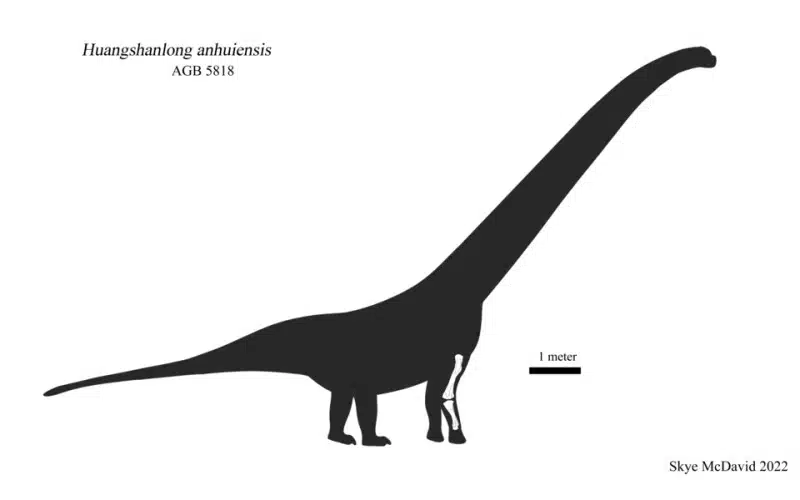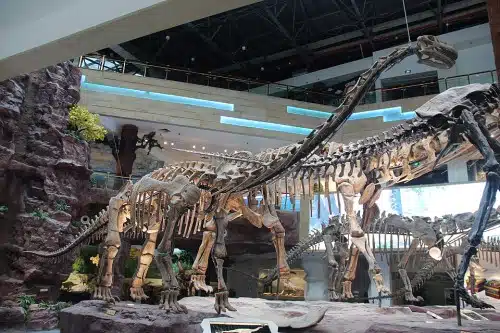Amid the rolling hills of Huangshan in Anhui Province, China, lies the buried legacy of a giant. Huangshanlong anhuiensis was a member of the sauropod family that lived over 160 million years ago. Though only fragments of its bones were unearthed, they were enough to reveal an animal of immense size and striking skeletal adaptations. This herbivorous dinosaur stood among the giants of its time, quietly shaping the forests and floodplains it roamed.
Discovered during a highway construction project, this mamenchisaurid adds another thread to the tapestry of China’s Middle Jurassic fauna. It’s not just another long-necked dinosaur—its unique limb proportions and distinctive bone features help paleontologists understand how these sauropods evolved and diversified. Its fossils are more than relics—they are clues to an ancient world teeming with life, movement, and transformation.
Huangshanlong Key Facts
| Keyword | Fact |
|---|---|
| Pronunciation | HWANG-shan-long |
| Meaning of name | Huangshan Dragon |
| Group | Sauropoda |
| Type Species | Huangshanlong anhuiensis |
| Diet | Herbivore |
| When it Lived | ~175 to 160 MYA |
| Period | Middle Jurassic |
| Length | ~33 to 36 feet |
| Height | ~8 feet at shoulder |
| Weight | ~6-10 tons |
| Mobility | Moved on all fours (quadrupedal) |
| First Discovery | 2002 by construction workers in the area |
| Described by | 2014 by Jian-Dong Huang, Hai-Lu You, Jing-Tao Yang, and Xin-Xin Ren |
| Holotype | AGB5818 |
| Location of first find | Shexian, Huangshan, Anhui Province, China |
Huangshanlong Origins, Taxonomy and Timeline
The name Huangshanlong directly references its place of origin—Huangshan in Anhui Province, China. The name combines “Huangshan” (黄山), meaning “Yellow Mountain,” with “long” (龙), the Chinese word for “dragon.” Together, they form “Huangshan Dragon,” a fitting title for this long-necked titan. Its species name, anhuiensis, further ties it to its provincial roots.

In terms of classification, this dinosaur belongs to Sauropoda, a group known for their massive size, long necks, and herbivorous diets. Within this iconic clade, it is part of the family Mamenchisauridae, a lineage renowned for possessing the most extremely elongated necks of any known sauropods. These dinosaurs pushed cervical proportions to the extreme, with necks that could span nearly half the length of their entire bodies—a feat unmatched among their long-necked relatives. The genus is Huangshanlong, and the type species—the only one described so far—is Huangshanlong anhuiensis.
Our long-necked subject lived during the Middle Jurassic, a slice of time spanning roughly from 174 to 160 million years ago. Though the exact epoch isn’t specified, the fossil site has been dated to the Hongqin/Dongyang Formation, which belongs to the Middle Jurassic. That places Huangshanlong in an era marked by rising sea levels, lush vegetation, and the diversification of both terrestrial and marine reptiles.
Discovery & Fossil Evidence
The first remains of this dinosaur were uncovered in July 2002 during highway construction in Shexian County, just three kilometers from downtown Huangshan. Fossils were found at Jimu Mountain, within a sedimentary sequence historically referred to as the Hongqin Formation, but now more commonly assigned to the Dongyang Formation—a Middle Jurassic unit characterized by red sandstones and siltstones. A rescue excavation quickly followed, led by the Anhui Provincial Institute of Archaeology, with field guidance provided by paleontologist Dong Zhiming.
The holotype specimen, catalogued as AGB5818, consists of a right humerus, radius, and ulna – so, most of the right forelimb minus the hand. These bones were exceptionally well-preserved and represent a single individual. While the remains are limited, their clarity and articulation provided enough information to distinguish this genus and species from other mamenchisaurids.
No additional specimens have been reported since that first discovery, and the fossils remain unique to the original site. Nevertheless, the preserved forelimb bones—marked by features such as humeral torsion and prominent accessory ridges—provide valuable anatomical data for distinguishing Huangshanlong from its close relatives and refining our understanding of mamenchisaurid diversity.
Huangshanlong Size and Description
Let’s begin with an overview. Though known from only a forelimb, the skeletal proportions of Huangshanlong reveal key details about its physical form. It would have showcased the classic body plan of sauropods: four thick, pillar-like limbs, a long neck, a relatively small head, and an extended tail. Its body was built for support and slow, deliberate movement. As with other mamenchisaurids, its adaptations suggest it browsed from mid to high vegetation layers.
Short description of Huangshanlong
Unsurprisingly, the defining characteristics of the dinosaur are restricted to its forelimb—the only part of its anatomy currently known. The humerus was straight and robust, slightly twisted laterally at the distal end—an outward torsion of about 25 degrees, a feature characteristic of mamenchisaurids. The ulna is two-thirds the length of the humerus, a proportion that appears slightly elongate compared to other known mamenchisaurids. This suggests subtle differences in forelimb posture or functional emphasis.
The overall construction of the limbs indicates an animal that supported its massive body with strength and stability rather than speed. Like its close relatives, this dinosaur was likely a slow mover, traversing floodplains and forested terrain at a steady, lumbering pace.
Size and Weight of Type Species
Estimates based on forelimb proportions suggest Huangshanlong anhuiensis was approximately 10 to 11 meters (33 to 36 feet) long from head to tail. Standing height at the shoulder may have reached around 2.2 to 2.4 meters (7.2 to 7.9 feet). Weight estimates, though tentative, likely fall between 6 and 10 metric tons (13,200 to 22,000 lbs), consistent with smaller to mid-sized members of Mamenchisauridae.
While no vertebrae or cranial bones were recovered, scaling from the preserved forelimb elements allows paleontologists to approximate the overall size of Huangshanlong anhuiensis. Based on these elements, it appears to have been smaller than gigantic forms like Mamenchisaurus sinocanadorum or Xinjiangtitan, but broadly comparable in scale to the smaller species of Omeisaurus or Mamenchisaurus youngi.
Although mass estimates for sauropods vary depending on modeling assumptions and the completeness of the fossil material, current data suggest a body mass typical of modestly sized mamenchisaurids.
The Dinosaur in Detail
What sets this dinosaur apart, at least tentatively, are a handful of distinctive features observed in its forelimb bones. The humerus exhibits a combination of traits that subtly differentiate it from other known mamenchisaurids, including an inward-tilting distal articulation surface and two forward-projecting processes centrally positioned along the anterior margin, as well as a muscular ridge extending along the proximal third of the shaft.
The ulna shows comparable nuance. Its inner and outer proximal projections form an angle just under 90 degrees, with the inner projection being notably longer—a condition uncommon among its close relatives. Additionally, three distinct ridges on the distal end likely served as muscle attachment sites, possibly reflecting subtle differences in forelimb function.
Taken together, these traits currently justify Huangshanlong anhuiensis as a valid genus and species. However, with the available material limited to a partial forelimb, it remains difficult to assess how sharply it can be distinguished from other closely related taxa. There is a possibility that some of its defining features may eventually prove to represent individual or intraspecific variation. Further fossil discoveries will be essential to better understand its position within Mamenchisauridae and to clarify whether these characteristics reflect genuine evolutionary divergence or natural variation within the group.
Interesting Points about Huangshanlong
- Its forelimb bones twist outward at the ends—a key trait of its mamenchisaurid family.
- Discovered during a road construction project, it was not found through traditional fossil hunting.
- It is the first Jurassic dinosaur ever identified in Anhui Province.
- Its radius and ulna are slightly elongated relative to the humerus – at least compared to other mamenchisaurids.
- Only a single partial specimen has been discovered, making it challenging to fully assess how distinct it is from closely related sauropods.
Contemporary Dinosaurs
One of the dinosaurs that shared the landscape with our main dino is the ornithischian Agilisaurus, a small, fast-moving herbivore. Likely thriving in open clearings or along the forest floor, this bipedal dinosaur filled a very different ecological niche from the towering Huangshanlong. Its agility and speed made it a difficult target for predators. Allowing it to coexist with much larger dinosaurs without direct competition.
Also present during this time was Omeisaurus, another mid-sized mamenchisaurid sauropod from southwestern China. Although it lived in a different region, it may have occupied a similar ecological niche, feeding on mid- to high-level vegetation. Morphological differences between the two could reflect subtle variations in behavior, habitat preference, or evolutionary lineage within Mamenchisauridae.
Another dinosaur that shared the landscape with our main dinosaur is Huayangosaurus. This armored stegosaurid was built for defense, with plates and spikes protecting its back and tail. It likely roamed the same floodplains, browsing on ferns and low vegetation. Its slow movements and body armor may have offered protection from contemporary predators, while Huangshanlong relied on sheer size for deterrence.
Another contemporary is Monolophosaurus, a theropod predator with a distinctive single crest on its head. While much smaller than Huangshanlong, it would have posed a threat to smaller herbivores. It’s unlikely that this predator would have targeted adult sauropods, but juveniles or the sick might not have been safe from its sharp teeth and agile frame.
Huangshanlong in its Natural Habitat
Picture a world of warm, seasonal climates, filled with rivers and red sandstone floodplains. This is where Huangshanlong lived. The rocks where its bones were found—now assigned to the Dongyang Formation—were laid down in a low-energy fluvial environment, with silt and fine sand hinting at gentle floodwaters. The landscape likely supported a variety of Jurassic plant life. Including conifers, cycads, and ferns, which would have provided abundant food for herbivores.
Though only its forelimbs are known, Huangshanlong is thought to have been a typical mamenchisaurid, and by analogy with its close relatives, it likely possessed a long neck adapted for browsing vegetation beyond the reach of smaller dinosaurs. As with other sauropods, it moved on all fours and relied on its sheer size and strength rather than speed or specialized defenses.
Whether it lived alone or in small groups remains uncertain, but its role in the ecosystem would have been significant. Like modern large herbivores, it may have helped shape the environment it lived in. Trampling vegetation, opening up forested areas, and possibly aiding in seed dispersal. Its presence would have influenced both the plant communities and the behaviors of predators and smaller herbivores around it.
Frequently Asked Questions
It was first discovered in 2002 by construction workers near Huangshan City in Anhui Province, China.
Huangshanlong was a sauropod dinosaur, specifically part of the Mamenchisauridae family, known for their extremely long necks.
Estimates suggest it reached about 30-40 feet in length and 8 feet in shoulder height. It weighed around 6 to 10 metric tons (13,200 to 22,000 lbs), about mid-sized for a mamenchisaurid.
As a herbivore, it fed on vegetation such as leaves from conifers and ferns in the Jurassic forests.
It was found in the Hongqin/Dongyang Formation near Shexian County, Huangshan, in Anhui Province, China.
So far, no other fossils of this dinosaur have been found outside the original site.
Sources
The information in this article is based on various sources, drawing on scientific research, fossil evidence, and expert analysis. The aim is to provide a comprehensive and accurate overview of Huangshanlong. However, please be aware that our understanding of dinosaurs and their world is constantly evolving as new discoveries are made.
Article last fact checked: Joey Arboleda, 09-05-2025
Featured Image Credit: Skye McDavid, CC BY 4.0, via Wikimedia Commons


